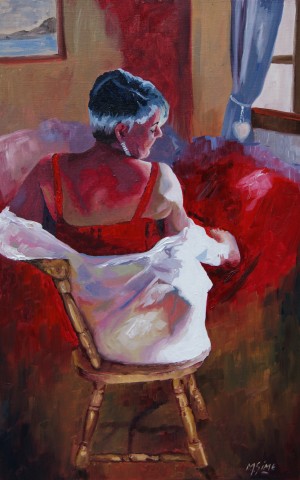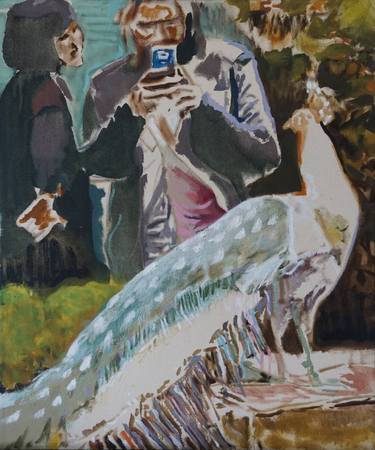Introducing the Secrets Behind Meaningful Figurative Oil Painting Styles
A Journey With the World of Metaphorical Oil Paint: Finding the Unique Qualities and Emotional Depth of the Medium

History of Figurative Oil Painting
Emerging during the late Middle Ages and flourishing throughout the Renaissance, figurative oil paint has an abundant history that mirrors both artistic development and social evolution. At first, oil paints were used in Europe as a way to improve the luminosity and depth of shade in art work. Artists such as Jan van Eyck originated the tool, demonstrating its prospective to catch elaborate details and textures, thus permitting a more natural depiction of the human kind.
As the Renaissance proceeded, prominent numbers like Leonardo da Vinci and Michelangelo broadened the boundaries of metaphorical oil paint. They highlighted anatomical accuracy and viewpoint, creating jobs that conveyed emotion and narrative depth. The tool's adaptability enabled experimentation with light and darkness, causing the development of chiaroscuro strategies that additionally enriched the aesthetic experience.
Distinct Characteristics of the Tool
The evolution of metaphorical oil painting has actually been significantly affected by the distinct features of the medium itself. Oil paint, made up of pigments suspended in oil, supplies musicians an impressive flexibility that allows for a variety of coatings and structures. Its slow drying time makes it possible for precise mixing and layering, which can create depth and luminosity unattainable in various other tools.
Furthermore, oil paint's abundant pigmentation offers vivid colors that preserve their strength over time. This characteristic is critical in figurative painting, where recording the subtleties of skin tones and psychological expressions is extremely important. The ability to accomplish refined slopes and soft transitions boosts the lifelike high quality of topics, permitting musicians to convey complex moods.
In addition, oil paint sticks well to numerous surfaces, such as steel, canvas, and wood, expanding the range of creative expression. The medium's flexibility supports various techniques, from comprehensive realistic look to meaningful brushwork, making it possible for musicians to discover their individual styles.
Inevitably, the unique residential properties of oil paint not only enrich the visual experience yet likewise encourage musicians to communicate extensive stories, making figurative oil paint a deeply evocative art kind.
Techniques and Designs Utilized
Within the world of metaphorical oil paint, artists use a diverse array of methods and styles that add to the depth and splendor of their job. One popular strategy is polishing, where transparent layers of paint are used over dried layers, allowing light to pass through and reflect, improving luminosity and depth. This method is typically made use of to accomplish a sense of realistic look and complexity in skin tones.
One more method is impasto, where thick layers of paint are used with a palette blade or brush, producing a distinctive surface that includes a three-dimensional high quality to the painting. This style can stimulate a visceral feedback, drawing the visitor in with its responsive nature.
Artists additionally check out numerous brushwork styles, from penalty, comprehensive strokes that record elaborate attributes to broader, a lot more expressive strokes that communicate activity and emotion (figurative oil painting). The option of shade palette significantly influences the total mood of a piece, with cozy tones why not try this out frequently giving sensations of convenience and cool tones recommending melancholy
Moreover, the integration of chiaroscuro, the contrast in between light and darkness, enables artists to produce remarkable results that enhance the narrative high quality of their job. Each strategy and style is very carefully picked to boost the viewer's experience and understanding.
Emotional Deepness in Metaphorical Art
Psychological deepness acts as a cornerstone in figurative art, enabling musicians to go beyond plain representation and engage audiences on a profound level. This emotional vibration is usually achieved through the nuanced portrayal of human figures, expressions, and communications. Artists harness the power of shadow, light, and color to evoke feelings that resonate deeply with the audience, creating a visceral connection to the subject matter.
In figurative oil painting, the elaborate layering of paint can show the complexities of human emotion. The choice of palette, whether warm or awesome, plays a vital function in establishing the state of mind and environment of a piece. Softer tones might stimulate harmony and self-questioning, while bold, contrasting shades can connect stress and drama.

Influential Artists and Their Works
Many significant artists have actually dramatically formed the landscape of figurative oil painting, each adding distinct point of views and methods that continue to inspire modern makers. Among these artists, Lucian Freud attracts attention for his intense mental deepness and raw representation of the human form, commonly obscuring the lines between charm and degeneration. Freud's jobs, characterized by thick, impasto brushstrokes, invite audiences to challenge the intricacies of identification and vulnerability.

Similarly, Andrew Wyeth's meticulous realistic look in items like "Christina's World" catches profound stories within apparently basic structures. His use of light and shadow evokes a feeling of fond memories and emotional resonance, attracting visitors into the intimate worlds he portrays.
In the world of contemporary art, Kehinde Wiley has gained acknowledgment for his vivid, epic portraits that challenge typical concepts of representation. By placing individuals of color in contexts reminiscent of timeless portrait, Wiley's work redefines the canon of art background.
These musicians, alongside others, have not just enriched metaphorical oil painting yet have also expanded the discussion surrounding emotion, society, and identity, ensuring that the tool stays an essential kind of expression in the art world. figurative oil painting.
Verdict
In final thought, figurative oil painting continues to be a powerful tool that encapsulates the intricacies of human emotion with its rich coloring and versatile methods. The historic development of this art kind, combined with its special characteristics, my latest blog post permits for profound creative expression. Strategies such as glazing and impasto enhance the psychological vibration of each piece, while the payments of significant artists proceed to motivate and shape the discourse bordering this timeless genre. The trip via figurative oil paint discloses its lasting relevance in the art globe.
The exploration of figurative oil paint uses a profound understanding into the interplay of method, feeling, and historic context that specifies this age-old medium. Oil paint, composed of pigments put on hold in oil, uses musicians a remarkable convenience that allows for a large variety of textures and finishes.Within the realm of figurative oil paint, musicians use a varied selection of strategies and designs that add to the deepness and richness of their work.Various prominent artists have considerably shaped the landscape of figurative oil painting, each adding one-of-a-kind viewpoints and strategies that proceed to influence contemporary developers.In conclusion, figurative oil paint stays a powerful medium that envelops the intricacies of human feeling through its rich coloring and flexible methods.